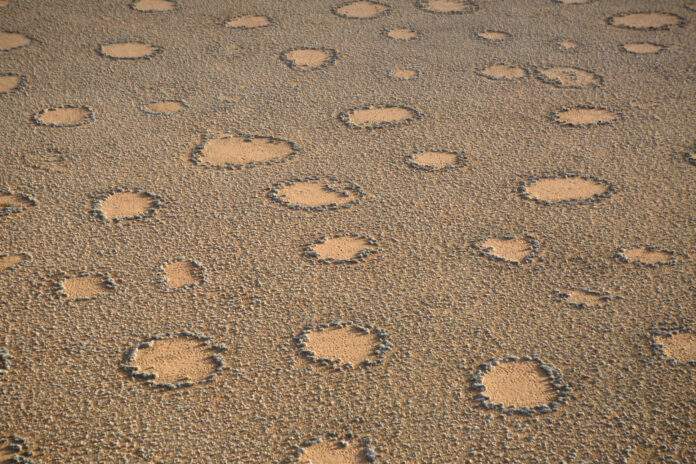The cause of the bizarre “fairy circles” that are found across the grasslands of Namibia may have been discovered by scientists.
These circles appear as hexagonal or round barren patches in the grassy scrub in the Namib desert and measure up to 39 feet across, and are also sometimes found in Western Australia. What causes these strange phenomena has mystified experts thus far, with the action of gods and spirits being the cause according to northern Namibian myth.
Now, however, researchers have found that these barren circles may form due to “death zones” in the soil, preventing grass from growing, according to a new paper in the journal Perspectives in Plant Ecology, Evolution and Systematics.
ISTOCK / GETTY IMAGES PLUS
The researchers found that the top 4 or 5 inches of the soil act as a “death zone,” causing fresh grass that attempts to grow within the circle to die 10 to 20 days after rainfall. This happens because the topsoil within the fairy circles is extremely prone to drying out quickly, causing plants that try to grow there to die before their roots can reach more moisturized soil deeper below.
“This is the cause of the death of the new grass in the fairy circle. Continuous soil moisture measurements over several years support this conclusion. This is because the soil water in the fairy circle only decreases noticeably quickly with the strengthening and regrowth of the surrounding grass after rain,” study author Stephan Getzin, a researcher at Göttingen University’s Ecosystem Modelling Department in Germany, said in a statement.
The grasses around the edges of the circle can easily access soil water up to 12 inches below the ground, allowing them to thrive.
“With their well-developed root system, these clumps of grass soak up the water particularly well. After the rain, they have a huge competitive advantage over the freshly germinated grasses in the fairy circle,” explains Getzin.
“The new grass only loses a small amount of water via transpiration from its small leaves, resulting in insufficient ‘suction power’ to pull new water from deeper soil layers.”
Additionally, these border plants are capable of drinking from the upper soil within the circles, further drying them out and making them devoid of water for other plants.
In the paper, the authors describe how they made this discovery after analyzing 500 grass plants across four areas of the Namib desert, measuring the length of their roots and leaves. They also measured the degree of soil moisture, both during and after the 2023 and 2024 rainy seasons.
These findings may imply that fairy circles act as water sources for drought-stressed plants in the Namib, with grasses growing around their perimeters to access their moisture.
“This self-organization can be described as ‘swarm intelligence.’ It is a systematic adaptation to a lack of resources in arid regions,” Getzin and co-author Hezi Yizhaq said in the statement.
These findings support previous research into what causes the phenomena that suggested the fairy circles might be some form of water stress response.
The fact that there was no termite damage found on the plants that attempted to grow within the fairy circles implies that previous theories—suggesting that termites were a driver of the circle formations—are untrue.
“In an extensive discussion of the publications on the sand termite theory, we show that so far, not a single field study with systematic measurement data on the root length of dying grasses has shown that termite feeding on the roots of newly germinated grasses creates the Namib fairy circles,” the researchers said.
Do you have a tip on a science story that Newsweek should be covering? Do you have a question about fairy circles? Let us know via [email protected].
Uncommon Knowledge
Newsweek is committed to challenging conventional wisdom and finding connections in the search for common ground.
Newsweek is committed to challenging conventional wisdom and finding connections in the search for common ground.


